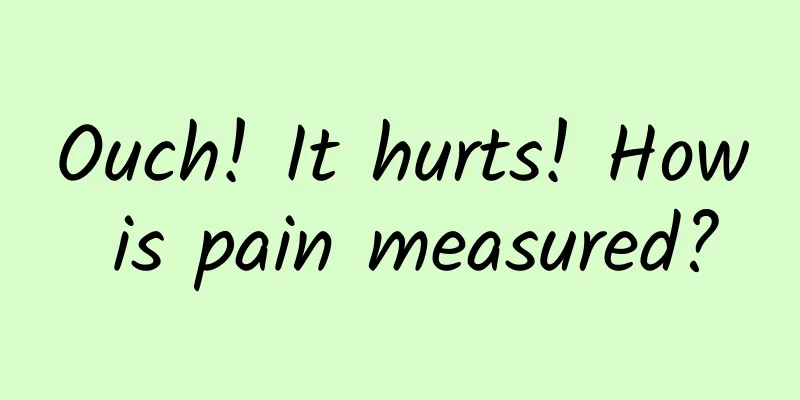Ouch! It hurts! How is pain measured?

|
Audit expert: Yin Tielun Deputy Chief Physician, Department of Neurology, Airport Branch, Peking University Third Hospital In life, the feeling of "pain" is everywhere. The pain of mosquito bites, the pain of knife scratches, the pain of sprained ankles, the pain of surgery... It is said that the most painful thing in the world is childbirth. Ordinary people would tremble in their hearts just thinking about it. But how do people perceive and classify pain? And what effects do different types of pain have on people? The source of pain from mosquito bites | pixabay What is pain Pain, also known as "pain sensation", is one of the human senses. It is an unpleasant subjective experience related to human damage or potential damage, and includes two parts: "pain sensation" and "pain response". "Pain sensation" refers to a person's subjective feeling of "pain", which mainly occurs in the cerebral cortex. "Pain response" refers to the various reactions of the human body when facing harmful stimuli, including the trunk and internal organs, and is usually related to neural activity, motor reflexes, and psychological emotions. "Pain response" is a reaction that humans and other animals have, such as increased heart rate, increased blood pressure, rapid breathing, sweating, fear, etc. However, "pain sensation" is unique to humans, and other animals do not have this "pain sensation". From the occurrence to the perception of pain, it often goes through several stages: contact injury stimulation-perception-transmission-pain center receiving information. Pain receptors are located at the nerve endings in the skin and other tissues. No matter what the stimulus is, it may trigger these receptors, causing the pain impulse to be quickly transmitted along the nerves to the spinal cord, and then through the spinal cord to the cerebral cortex, thus causing perceived pain. Source of pain transmission丨Xinhuanet Pain necessity and pain classification Pain is so uncomfortable, so would it be better without it? Not really. Some people may think that people who can't feel pain are really lucky, but little do they know that "no pain" is also a disease. Pain is actually a warning taken by the human body to protect itself from harm. It will cause a series of defensive protective reactions in the body, thereby reducing the degree of harm. Without the sense of pain, we would not protect ourselves when we encounter danger or physical injury, and in doing so, we would put ourselves in greater danger. Therefore, as an alarm system for the body's condition, pain is necessary and important, and is one of the indispensable senses of the human body. Back pain source | pixabay Pain classification is the classification of pain levels in the medical community. Since pain is a subjective feeling, many factors such as physiology, psychology, and social culture may affect people's perception of pain. If pain can be assessed correctly, doctors will have a more objective and scientific diagnosis of the patient's condition, which has important practical significance for the formulation and implementation of subsequent treatment plans. Common pain rating methods There are many methods for grading pain in the world, including unidimensional and multidimensional assessment methods. Among them, the unidimensional pain assessment table is the most commonly used assessment type in clinical practice. Visual Analogue Scale (VAS) VAS is a commonly used assessment tool for measuring pain intensity. It consists of a 100mm straight line with "completely painless" on one end and "extreme pain" on the other. Patients need to use marks on this line to express their pain feelings, which is relatively simple to operate. Source of VAS assessment form | "Chinese Expert Consensus on the Application of Pain Assessment Scales (2020)" However, VAS assessment requires patients to have a certain level of abstract thinking, which is not friendly to the elderly and children. Therefore, on this basis, experts created the facial VAS assessment form, adding cartoon images with different expressions to the original form, making the assessment content more intuitive and vivid. Source of F-VSA Assessment Form | "Chinese Expert Consensus on the Application of Pain Assessment Scales (2020)" Revised Wong-Baker Facial Pain Scale (FPS-R) Another method that uses cartoon images is the FPS method, which was developed by Dr. Donna Wong and Dr. Connie Baker specifically for children. It combines facial expressions, numbers, text and other forms, making it both vivid and graphic. Source of FPS assessment method | "Chinese Expert Consensus on the Application of Pain Assessment Scales (2020)" However, since different people have different understandings of cartoon expressions, this solution will inevitably have regional and cultural differences and has certain limitations. Numerical Rating Scale (NRS) There are multiple versions of the NRS scoring scheme, the most commonly used is the NRS 0-10 version. Patients need to choose a number from 0 to 10 to indicate their pain sensation according to their own situation, where 0 means no pain, 1-3 means mild pain, 4-6 means moderate pain, and 7-10 means severe pain. Source of NRS scoring method | "Chinese Expert Consensus on the Application of Pain Assessment Scales (2020)" In daily life, things like clapping hard and being bitten by a mosquito can be classified as mild pain, i.e., level 1-3, while being cut by a knife, spraining an ankle, etc. are moderate pain (level 4-6). Pain such as childbirth, migraine, and cancer pain can be classified as severe pain, i.e., level 7-10. Source of NRS scoring method | MedSci official website WTO pain scale The World Health Organization has also developed its own classification method for pain. It divides pain into 4 levels: 0 degree: no pain; Grade I: Mild, intermittent pain, no medication required; Grade II: moderate, continuous pain that affects rest and requires painkillers; Grade III: severe, continuous pain that cannot be relieved without medication; Grade IV: Severe, continuous severe pain, accompanied by changes in blood pressure, pulse, etc. Pain is a protective signal from our body. When you feel pain, you must find out the cause. Do not just endure the pain. Seek medical attention when necessary to avoid delaying treatment. |
<<: Can you believe it? Whales not only have legs, but are also cousins of hippos
Recommend
Why did Geely's new energy vehicles only rank tenth in sales last year and most of them were sold domestically?
New energy vehicles are the general trend. Both t...
Traffic generation and promotion: Are there any better ways to generate traffic on the entire network?
There are dozens of drainage methods online. Can ...
"Coal" speaks "wisdom": What kind of sparks will be created when coal miners encounter intelligence?
The 2024 China Guizhou International Energy Indus...
GAC Aion: As of August 2023, the cumulative sales of the AION S series exceeded 400,000, ranking first in the A-class pure electric sedan
GAC Aion announced that the AION S series sold 22...
How much does it cost to produce a real estate mini program on the market in Baishan?
Baishan real estate applet production price 1. Di...
Pinduoduo Operations: What tricks does Pinduoduo use to get things for free through bargaining?
The bargaining and free-getting activities that h...
5 Ways to Use KOL Marketing
Now if you ask yourself what a KOL is, can you an...
Biden pushes for new energy vehicle development, six major U.S. utilities work together to build a charging network
The six major U.S. utility companies recently joi...
What’s the point of doing business if you can’t find any competitors?
How many times have you heard this? Anyway, I hav...
Is there a "guide to picking wild vegetables in a closed community" circulating in the circle of friends? Experts give an urgent reminder
Recently, some rumors have been circulating onlin...
When using a mobile phone, what are the reasons for partial malfunction of the touch screen, and how to solve the problem?
What are the reasons for the failure of part of t...
Mini Program Mall Development Company, how to make a mini program on WeChat?
Unconsciously, it is the "Double 11 Festival...
These 7 types of vegetables have "toxins" and must be blanched before eating! One of them is in season now!
Blanching is one of the cooking methods we usuall...
Solid info! The 5 most overrated bidding strategies
Search engine paid promotion provides marketers w...
How to dominate the circle of friends in the flower photography contest? Here are 6 techniques for taking photos of flowers in spring
Spring is here, and the annual flower photography...


![[Smart Farmers] "World Heritage", "Intangible Heritage", "Agricultural Heritage"... Counting Chinese Tea in Cultural Heritage](/upload/images/67f21cc57d455.webp)






